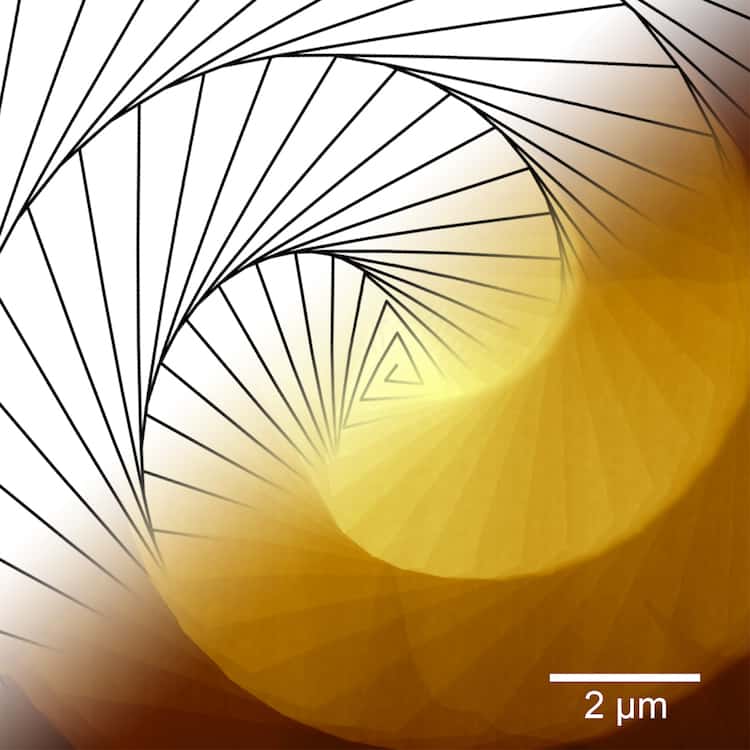
Researchers have found a way to grow layers of two-dimensional (2D) materials with predictable interlayer twists, dispensing with the need to stack and twist separately-grown layers by hand. The new technique uses curved growth surfaces and could provide a significant boost to the field of “twistronics” – a new approach to tuning the electronic properties of materials and engineering future devices.
In recent years, physicists and materials scientists have explored ways of using the weak (van der Waals) coupling between stacked, atomically-thick layers of material to manipulate the material’s properties. The most famous example is graphene, a 2D sheet of carbon atoms. Graphene does not normally have an electronic band gap, but it can be made to develop one when placed on top of hexagonal boron nitride (hBN), a 2D material with a similar lattice constant. If these stacked layers of graphene and hBN are twisted, however, the angle between the graphene and hBN lattices increases, reducing the van der Waals coupling and causing the band gap to disappear. In this fashion, graphene can be made to act like a metal or a semiconductor simply by varying the angle between layers. What is more, placing two layers of graphene together and rotating them at a “magic” angle of 1.1° relative to each other transforms metallic graphene into a superconductor.
This emerging science of “twistronics” thus offers a way of controlling a material’s electronic properties that does not require changing its chemical make-up, as conventional techniques (such as doping) do. But there is a problem: creating these stacks of materials usually requires researchers to exfoliate or synthesize layers of 2D materials separately before stacking and twisting them – a painstaking manual process.
Curved surfaces
A team led by Song Jin of the University of Wisconsin-Madison in the US has now overcome this challenge by exploiting non-Euclidean (curved) surfaces and a type of crystal imperfection called a screw dislocation to grow twisted 2D crystals. In 2D materials, these screw dislocations cause a spiral structure to form in which all the layers throughout the stack are connected and the orientation of every layer is aligned – sort of like a ramp in a multi-storey car park, Jin explains.
In their experiments, the Wisconsin researchers placed nanoparticles of silicon oxide under the centres of their spirals of 2D materials. This nanoparticle disrupts the previously flat surface, creating a curved foundation for their 2D crystal (made, in this case, from the transition metal dichalcogenides tungsten disulphide or tungsten diselenide) to grow on.
In this situation, instead of an aligned spiral in which the edge of each layer lies parallel to the previous layer, the researchers found that the 2D crystal forms a multilayer spiral that continually twists in a predictable way from one layer to the next. The angle of the interlayer twist stems from a mismatch between the flat 2D crystals and the curved surfaces they grow on, they explain, and two different types of spiral are possible. When a spiral structure grows directly over the nanoparticle, it creates a pattern that lead author Yuzhou Zhao dubs a “fastened spiral”. A structure grown over an off-centre nanoparticle, in contrast, is termed an “unfastened spiral”.
Models and measurements
To explain this behaviour, Zhao developed a mathematical model that predicts the twist angles of spirals based on the geometry of the curved surfaces. These modelled shapes generally agree with the structures he grew in the laboratory. In addition, electron microscopy measurements by Chengyu Zhang and Paul Voyles, also at Wisconsin, show that lattices of atoms on neighbouring twisted layers form an overlapping interference (moiré) pattern – as expected.

A decade of Physics World breakthroughs: 2018 – Discovery of ‘magic-angle graphene’
While the researchers used tungsten disulphide and tungsten diselenide to show how twisted material could be grown, they note that the concept of twisting spirals could be extended to other 2D materials. “We can now follow a rational model rooted in mathematics to create a stack of 2D layers with a controllable twist angle between every layer,” Zhao says. “Being able to directly synthesize twisting 2D materials in this way will allows us to study novel quantum physics in these materials.”
Full details of the research are reported in Science.
